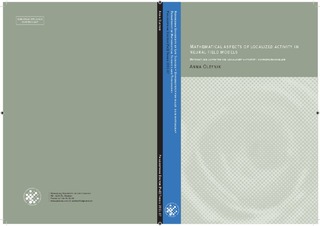| dc.contributor.advisor | Wyller, John | |
| dc.contributor.advisor | Ponossov, Arkadi | |
| dc.contributor.author | Oleynik, Anna | |
| dc.date.accessioned | 2017-03-15T11:40:36Z | |
| dc.date.available | 2017-03-15T11:40:36Z | |
| dc.date.issued | 2011 | |
| dc.identifier.isbn | 978-82-575-1000-8 | |
| dc.identifier.issn | 1503-1667 | |
| dc.identifier.uri | http://hdl.handle.net/11250/2434179 | |
| dc.description.abstract | Neural field models assume the form of integral and integro-differential equations, and describe non-linear interactions between neuron populations. Such models reduce the dimensionality and complexity of the microscopic neural-network dynamics and allow for mathematical treatment, efficient simulation and intuitive understanding. Since the seminal studies byWilson and Cowan (1973) and Amari (1977) neural field models have been used to describe phenomena like persistent neuronal activity, waves and pattern formation in the cortex. In the present thesis we focus on mathematical aspects of localized activity which is described by stationary solutions of a neural field model, so called bumps.
While neural field models represent a considerable simplification of the neural dynamics in a large network, they are often studied under further simplifying assumptions, e.g., approximating the firing-rate function with a unit step function.
In some cases these assumptions may not change essential features of the model, but in other cases they may cause some properties of the model to vary significantly or even break down. The work presented in the thesis aims at studying properties of bump solutions in one- and two-population models relaxing on the common simplifications.
Numerical approaches used in mathematical neuroscience sometimes lack mathematical justification. This may lead to numerical instabilities, ill-conditioning or even divergence. Moreover, there are some methods which have not been used in neuroscience community but might be beneficial. We have initiated a work in this direction by studying advantages and disadvantages of a wavelet-Galerkin algorithm applied to a simplified framework of a one-population neural field model. We also focus on rigorous justification of iteration methods for constructing bumps.
We use the theory of monotone operators in ordered Banach spaces, the theory of Sobolev spaces in unbounded domains, degree theory, and other functional analytical methods, which are still not very well developed in neuroscience, for analysis of the models. | nb_NO |
| dc.description.abstract | Nevrofeltmodeller formuleres som integral og integro-differensiallikninger. De beskriver ikke-lineære vekselvirkninger mellom populasjoner av nevroner. Slike modeller reduserer dimensjonalitet og kompleksitet til den mikroskopiske nevrale nettverksdynamikken og tillater matematisk behandling, effektiv simulering og intuitiv forståelse. Siden pionerarbeidene til Wilson og Cowan (1973) og Amari (1977), har nevrofeltmodeller blitt brukt til å beskrive fenomener som vedvarende nevroaktivitet, bølger og mønsterdannelse i hjernebarken. I denne avhandlingen vil vi fokusere på matematiske aspekter ved lokalisert aktivitet som beskrives ved stasjonære løsninger til nevrofeltmodeller, såkalte bumps.
Mens nevrofeltmodeller innebærer en betydelig forenkling av den nevrale dynamikken i et større nettverk, så blir de ofte studert ved å gjøre forenklende tilleggsantakelser, som for eksempel å approksimere fyringratefunksjonen med en Heaviside-funksjon.
I noen tilfeller vil disse forenklingene ikke endre vesentlige trekk ved modellen, mens i andre tilfeller kan de forårsake at modellegenskapene endres betydelig eller at de bryter sammen. Arbeidene presentert i denne avhandlingen har som mål å studere egenskapene til bump-løsninger i en- og to-populasjonsmodeller når en lemper på de vanlige antakelsene.
Numeriske teknikker som brukes i matematisk nevrovitenskap mangler i noen tilfeller matematisk begrunnelse. Dette kan lede til numeriske instabiliteter, dårlig kondisjonering, og til og med divergens. I tillegg finnes det metoder som ikke er blitt brukt i nevrovitenskap, men som kunne være fordelaktige å bruke. Vi har startet et arbeid i denne retningen ved å studere fordeler og ulemper ved en wavelet-Galerkin algoritme anvendt på et forenklet rammeverk for en en-populasjons nevrofelt modell. Vi fokuserer også på rigorøs begrunnelse for iterasjonsmetoder for konstruksjon av bumps.
Vi bruker teorien for monotone operatorer i ordnede Banachrom, teorien for Sobolevrom for ubegrensede domener, gradteori, og andre funksjonalanalytiske metoder, som for tiden ikke er vel utviklet i nevrovitenskap, for analyse av modellene. | nb_NO |
| dc.language.iso | eng | nb_NO |
| dc.publisher | Norwegian University of Life Sciences, Ås | nb_NO |
| dc.relation.ispartofseries | PhD Thesis;2011:37 | |
| dc.rights | Attribution-NonCommercial-NoDerivatives 4.0 Internasjonal | * |
| dc.rights.uri | http://creativecommons.org/licenses/by-nc-nd/4.0/deed.no | * |
| dc.title | Mathematical aspects of localized activity in neural field models | nb_NO |
| dc.title.alternative | Matematiske aspekter ved lokalisert aktivitet i nevrofeltmodeller | nb_NO |
| dc.type | Doctoral thesis | nb_NO |
| dc.subject.nsi | VDP::Mathematics and natural science: 400::Mathematics: 410 | nb_NO |
| dc.source.pagenumber | 1 b. (flere pag.) | nb_NO |
| dc.relation.project | Norges Forskningsråd: 178892 ; Norges Forskningsråd 178901 | nb_NO |

